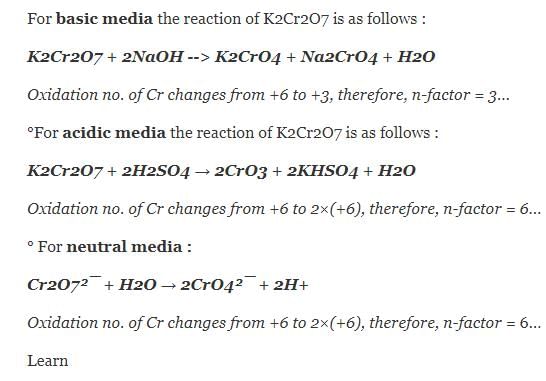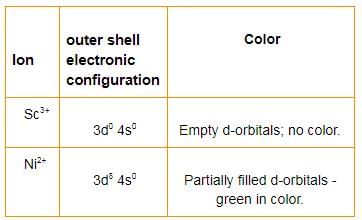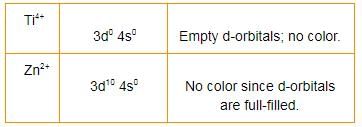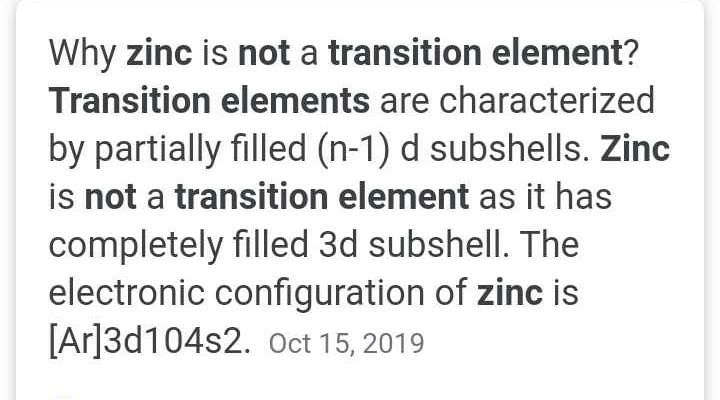All Exams >
NEET >
Chemistry CUET UG Mock Test Series 2026 >
All Questions
All questions of D and F - Block Elements for NEET Exam
Can you explain the answer of this question below:Which one of the following is a diamagnetic ion?- A:CO2+
- B:Cu2+
- C:Mn2+
- D:Sc3+
The answer is d.
Which one of the following is a diamagnetic ion?
A:
CO2+
B:
Cu2+
C:
Mn2+
D:
Sc3+

|
Learners Habitat answered |
Co+2 = [Ar] 3d7
Cu2+ = [Ar] 3d9
Mn+2 = [Ar] 3d5
Sc+3 = [Ar]
We can see that only Sc+3 has no unpaired electron, so it is a diamagnetic ion.
Cu2+ = [Ar] 3d9
Mn+2 = [Ar] 3d5
Sc+3 = [Ar]
We can see that only Sc+3 has no unpaired electron, so it is a diamagnetic ion.
Which one of the following exists in the oxidation state other than +3?- a)B
- b)Al
- c)Ce
- d)Ga
Correct answer is option 'C'. Can you explain this answer?
Which one of the following exists in the oxidation state other than +3?
a)
B
b)
Al
c)
Ce
d)
Ga
|
|
Vivek Rana answered |
The correct answer is option C
Ce exist in the oxidation state other than +3 .
(a) B - Boron has +1 and +3 oxidation state.
(b) Al - Aluminium has +1,+2 and +3 oxidation state.
(c) Ce - Cerium has +3 and +4 oxidation state.
(d) Ga - Gallium has +1 and +3 oxidation state.
Cerium (Ce) have [Xe] 4f²6s² electronic configuration.
Which form of silver is colourless?- a)Ag2+
- b)Ag
- c)Ag3+
- d)Ag+
Correct answer is option 'D'. Can you explain this answer?
Which form of silver is colourless?
a)
Ag2+
b)
Ag
c)
Ag3+
d)
Ag+
|
|
Om Desai answered |
ilver in the form of Ag+ is colourless. For transition metal ions to exhibit color, their metal ions must have incompletely filled (n-1)d orbitals.
Ag+ =4d10,5s0
Ag+ has completely filled d orbitals hence is colourless.
Which ion will show more paramagnetic behaviour ?- a)Cu+
- b)Fe2+
- c)Ag+
- d)Fe3+
Correct answer is option 'D'. Can you explain this answer?
Which ion will show more paramagnetic behaviour ?
a)
Cu+
b)
Fe2+
c)
Ag+
d)
Fe3+
|
|
Lavanya Menon answered |
Since the configuration of Fe3+ ion is (argon ) 3d5,which contains maximum number of unpaired electrons, hence more will be paramagnetic behavior.
Which among the following is colourless?- a)Sc2+
- b)Zn2+
- c)Ti3+
- d)V3+
Correct answer is option 'B'. Can you explain this answer?
Which among the following is colourless?
a)
Sc2+
b)
Zn2+
c)
Ti3+
d)
V3+
|
|
Krishna Iyer answered |
Zn2+ has completely filled d-orbitals and there are no vacant d-orbitals for the transition of electrons, hence it is colourless.
The first ionization energy of the d-block elements are?- a)Lesser than p-block elements
- b)Between s and p-block elements
- c)Lesser than s-block elements
- d)Higher than p-block elements
Correct answer is option 'B'. Can you explain this answer?
The first ionization energy of the d-block elements are?
a)
Lesser than p-block elements
b)
Between s and p-block elements
c)
Lesser than s-block elements
d)
Higher than p-block elements
|
|
Rahul Bansal answered |
The first ionization energy of the d-block elements are between s and p-block elements. Thus they are more electropositive than p-block elements and less electropositive than s-block elements.
Statement TypeDirection (Q. No. 25) This section is based on Statement I and Statement II. Select the correct answer from the codes given below.Q. Statement I : The highest oxidation state of osmium is +8.Statement II : Osmium is a 5-d block element.- a)Both Statement I and Statement II are correct and Statement II is the correct explanation of Statement I
- b)Both Statement I and Statement II are correct but Statement II is not the correct explanation of Statement I
- c)Statement I is correct but Statement II is incorrect
- d)Statement II is correct but Statement I is incorrect
Correct answer is option 'A'. Can you explain this answer?
Statement Type
Direction (Q. No. 25) This section is based on Statement I and Statement II. Select the correct answer from the codes given below.
Q.
Statement I : The highest oxidation state of osmium is +8.
Statement II : Osmium is a 5-d block element.
a)
Both Statement I and Statement II are correct and Statement II is the correct explanation of Statement I
b)
Both Statement I and Statement II are correct but Statement II is not the correct explanation of Statement I
c)
Statement I is correct but Statement II is incorrect
d)
Statement II is correct but Statement I is incorrect

|
Vikas Saini answered |
B hona chayie
Brass is an alloy of:- a)Copper and molybdenum
- b)Copper and zinc
- c)Copper and tungsten
- d)Copper and tin
Correct answer is option 'B'. Can you explain this answer?
Brass is an alloy of:
a)
Copper and molybdenum
b)
Copper and zinc
c)
Copper and tungsten
d)
Copper and tin
|
|
Krishna Iyer answered |
Brass is an alloy of copper and zinc, in proportions which can be varied to achieve varying mechanical and electrical properties.It is a substitutional alloy: atoms of the two constituents may replace each other within the same crystal structure.
Brass is similar to bronze, another alloy containing copper that uses tin in place of zinc; both bronze and brass may include small proportions of a range of other elements including arsenic, lead, phosphorus, aluminum, manganese, and silicon.
Brass is similar to bronze, another alloy containing copper that uses tin in place of zinc; both bronze and brass may include small proportions of a range of other elements including arsenic, lead, phosphorus, aluminum, manganese, and silicon.
Which of the following group of elements are not regarded as transition elements?- a)Sc,Y,La
- b)Cu, Ag, Au
- c)Zn, Cd, Hg
- d)Cr ,Mo,W
Correct answer is option 'C'. Can you explain this answer?
Which of the following group of elements are not regarded as transition elements?
a)
Sc,Y,La
b)
Cu, Ag, Au
c)
Zn, Cd, Hg
d)
Cr ,Mo,W
|
|
Neha Sharma answered |
Zn, Cd & Hg because the d-orbital of these elements are completely filled. So, they don't show the characteristics of transition elements (i.e. the d-orbital of transition elements is incomplete.
The inner transition elements are the elements in which the added electrons go to:- a)(n-1)d-orbitals
- b)(n-1)d-orbitals and (n-1)f-orbitals
- c)(n-1)d-orbitals and ns orbitals
- d)(n-2)f-orbitals
Correct answer is option 'D'. Can you explain this answer?
The inner transition elements are the elements in which the added electrons go to:
a)
(n-1)d-orbitals
b)
(n-1)d-orbitals and (n-1)f-orbitals
c)
(n-1)d-orbitals and ns orbitals
d)
(n-2)f-orbitals
|
|
Rohit Shah answered |
Lanthanides and actinides are called inner transition elements because they are a group of elements that are shown as the bottom two rows of the periodic table. ... Lanthanides and actinides belong to the f-block elements, which means that they have filled up their f-orbitals with electrons.
Number of electrons with l = 2 and s = 1/2 in zinc atom are
Correct answer is '5'. Can you explain this answer?
Number of electrons with l = 2 and s = 1/2 in zinc atom are
|
|
Krishna Iyer answered |
l = 2 means d-subshell. Zinc has 10 electrons ind-subshell in which 5 electrons are + 1/2 spin and 5 electrons are - 1/2.
One Integer Value Correct TypeDirection (Q. Nos. 20-24) This section contains 5 questions. When worked out will result in an integer from 0 to 9 (both inclusive).Q. The number of elements that do not have completely filled d subshell among the elements Ni, Pd, Pt, Cu, Ag, Au, Zn, Cd and Hg are
Correct answer is '2'. Can you explain this answer?
One Integer Value Correct Type
Direction (Q. Nos. 20-24) This section contains 5 questions. When worked out will result in an integer from 0 to 9 (both inclusive).
Q.
The number of elements that do not have completely filled d subshell among the elements Ni, Pd, Pt, Cu, Ag, Au, Zn, Cd and Hg are
|
|
Preeti Iyer answered |
Ni has 3d84s2 and Pt has 5d96s1.
Observe the following statements. Which is correct statement regarding lanthanides?- a)Cerium shows + 4 and + 3 oxidation states
- b)Element with atomic numbers 66 and 99 belong to f-block
- c)Lanthanides belong to 3rd group and 7th period
- d)Monazite is the mineral that constitutes the major source of the lanthanides
Correct answer is option 'B'. Can you explain this answer?
Observe the following statements. Which is correct statement regarding lanthanides?
a)
Cerium shows + 4 and + 3 oxidation states
b)
Element with atomic numbers 66 and 99 belong to f-block
c)
Lanthanides belong to 3rd group and 7th period
d)
Monazite is the mineral that constitutes the major source of the lanthanides
|
|
Suresh Iyer answered |
The correct answer is option B
Ce shows +4 oxidation state in aq.solution
Ce (58) to lu (71)- lanthanide
Th (90) to Lr (103)- actinoids.
Ce shows +4 oxidation state in aq.solution
Ce (58) to lu (71)- lanthanide
Th (90) to Lr (103)- actinoids.
A red solid is insoluble in water. However, it becomes soluble if some KI is added to water. Heating the red solid in a test tube results in liberation of some violet coloured fumes and droplets of a metal appear on the cooler parts of the test tube. The red solid is - a)(NH4)2Cr2O7
- b)HgI2
- c)HgO
- d)Pb3O4
Correct answer is option 'B'. Can you explain this answer?
A red solid is insoluble in water. However, it becomes soluble if some KI is added to water. Heating the red solid in a test tube results in liberation of some violet coloured fumes and droplets of a metal appear on the cooler parts of the test tube. The red solid is
a)
(NH4)2Cr2O7
b)
HgI2
c)
HgO
d)
Pb3O4

|
Infinity Academy answered |
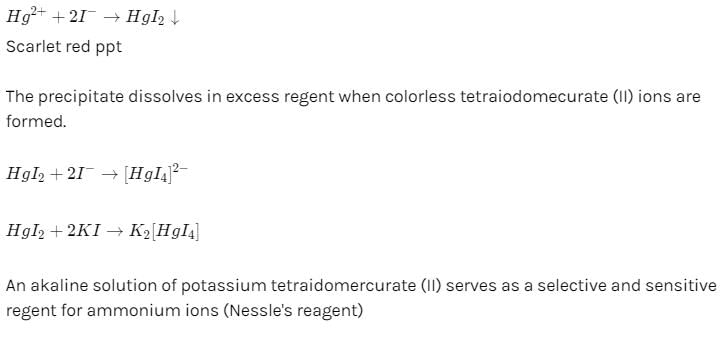
The elements which lie between s and p block elements in the long form periodic table are called as:- a)Actinides
- b)d-block elements
- c)Lanthanides
- d)Electropositive elements
Correct answer is option 'B'. Can you explain this answer?
The elements which lie between s and p block elements in the long form periodic table are called as:
a)
Actinides
b)
d-block elements
c)
Lanthanides
d)
Electropositive elements
|
|
Harsh Desai answered |
D-block elements
The long form periodic table consists of four blocks: s, p, d, and f. The s and p blocks are located on the left and right sides of the periodic table, respectively. The d-block elements are located in the middle of the periodic table, between the s and p blocks. These elements are also known as transition elements.
Explanation:
The d-block elements are characterized by the presence of partially filled d-orbitals in their valence shells. These elements are often referred to as transition elements because they exhibit a transition between the highly reactive s-block elements and the relatively inert p-block elements. The d-block elements are known for their unique chemical and physical properties, such as their ability to form complex ions and their high melting and boiling points.
Examples of d-block elements include titanium, iron, copper, and zinc. These elements are widely used in industry and technology due to their unique properties, such as their strength, durability, and conductivity.
In summary, the elements which lie between s and p block elements in the long form periodic table are called d-block elements or transition elements. These elements exhibit unique chemical and physical properties and are widely used in industry and technology.
The long form periodic table consists of four blocks: s, p, d, and f. The s and p blocks are located on the left and right sides of the periodic table, respectively. The d-block elements are located in the middle of the periodic table, between the s and p blocks. These elements are also known as transition elements.
Explanation:
The d-block elements are characterized by the presence of partially filled d-orbitals in their valence shells. These elements are often referred to as transition elements because they exhibit a transition between the highly reactive s-block elements and the relatively inert p-block elements. The d-block elements are known for their unique chemical and physical properties, such as their ability to form complex ions and their high melting and boiling points.
Examples of d-block elements include titanium, iron, copper, and zinc. These elements are widely used in industry and technology due to their unique properties, such as their strength, durability, and conductivity.
In summary, the elements which lie between s and p block elements in the long form periodic table are called d-block elements or transition elements. These elements exhibit unique chemical and physical properties and are widely used in industry and technology.
Which of the following is not an interstitial compound?- a)Mn4N
- b)TiC
- c)Fe3H
- d)FeCl3
Correct answer is option 'D'. Can you explain this answer?
Which of the following is not an interstitial compound?
a)
Mn4N
b)
TiC
c)
Fe3H
d)
FeCl3
|
|
Lavanya Menon answered |
The correct answer is option D
An interstitial compound is a compound that is formed when an atom with a small enough radius sits a hole in a metal lattice
They are usually transitional elements
Eg: Tic, Mn4N, Fe3H, TiH2 etc.
Main Characteristics:-
· High melting points than metals
· They are much harder
· They become chemically inert
· They become less malleable
So, the answer is (a), (b), (c) .
An interstitial compound is a compound that is formed when an atom with a small enough radius sits a hole in a metal lattice
They are usually transitional elements
Eg: Tic, Mn4N, Fe3H, TiH2 etc.
Main Characteristics:-
· High melting points than metals
· They are much harder
· They become chemically inert
· They become less malleable
So, the answer is (a), (b), (c) .
The second series of transition element starts with:- a)Scandium
- b)Rhodium
- c)Ytterium
- d)Actinium
Correct answer is option 'C'. Can you explain this answer?
The second series of transition element starts with:
a)
Scandium
b)
Rhodium
c)
Ytterium
d)
Actinium
|
|
Pooja Mehta answered |
The second series includes the elements yttrium (symbol Y, atomic number 39) to cadmium (symbol Cd, atomic number 48)
In neutral solution, potassium permanganate forms:- a)Manganese dioxide
- b)Manganous sulphate
- c)Pyrolusite
- d)Potassium manganite
Correct answer is option 'A'. Can you explain this answer?
In neutral solution, potassium permanganate forms:
a)
Manganese dioxide
b)
Manganous sulphate
c)
Pyrolusite
d)
Potassium manganite

|
Prakash answered |
KMno₄ is an oxidising agent (here Mn⁺⁷)in nuetral medium there is a change of 3 in it's oxidation state M⁺⁷-------Mn⁺⁴
Melting point of d block elements across a period:- a)Increases from left to right
- b)Deceases from left to right
- c)Increases to a maximum at d5 and then decreases with increase of atomic number.
- d)Does not change on moving from left to right.
Correct answer is option 'C'. Can you explain this answer?
Melting point of d block elements across a period:
a)
Increases from left to right
b)
Deceases from left to right
c)
Increases to a maximum at d5 and then decreases with increase of atomic number.
d)
Does not change on moving from left to right.
|
|
Jayant Mishra answered |
The melting and boiling points first increase, reaches maximum and then steadily decrease across any transition series. ... The low melting points of Zn, Cd, and Hg are due to the absence of unpaired d-electrons in their atoms and thus low metallic bonding.
Which one is of the following is the lightest transition element?- a)Ti
- b)Sc
- c)Fe
- d)Hg
Correct answer is option 'B'. Can you explain this answer?
Which one is of the following is the lightest transition element?
a)
Ti
b)
Sc
c)
Fe
d)
Hg
|
|
T.ttttt answered |
Scandium (Sc) is the lightest transition element. It is the first element in the 3d transition series. Among the transition elements, Sc has the lowest density.
Which of the following is not the condition for the complex formation?- a)High ionic charge density on metal ion.
- b)Smaller size of transition metal ion.
- c)Absence of vacant d-orbitals.
- d)Availability of vacant d-orbitals.
Correct answer is option 'C'. Can you explain this answer?
Which of the following is not the condition for the complex formation?
a)
High ionic charge density on metal ion.
b)
Smaller size of transition metal ion.
c)
Absence of vacant d-orbitals.
d)
Availability of vacant d-orbitals.

|
Gunjan Lakhani answered |
The correct answer is Option C
Only d orbitals accept the lone pair of electrons during complex formation. Their absence means that the atom will not be able to accept the lone pair of electrons and the complex will not be formed.
Only d orbitals accept the lone pair of electrons during complex formation. Their absence means that the atom will not be able to accept the lone pair of electrons and the complex will not be formed.
Transition metals with highest melting point is- a)Cr
- b)W
- c)Hg
- d)Sc
Correct answer is option 'B'. Can you explain this answer?
Transition metals with highest melting point is
a)
Cr
b)
W
c)
Hg
d)
Sc

|
Pragati Choudhury answered |
W belongs to 5d series and also it have lot of unpaired electrons thus it forms strong metallic bonding.
Only One Option Correct TypeDirection (Q. Nos. 1- 10) This section contains 10 multiple choice questions. Each question has four choices (a), (b), (c) and (d), out of which ONLY ONE is correct.Q. Set of continuous atomic numbers of elements are present in the same group as well as same period.- a)56,57,58,59
- b)88,89,90,91
- c)101,102,103,104
- d)68,69,70,71
Correct answer is option 'D'. Can you explain this answer?
Only One Option Correct Type
Direction (Q. Nos. 1- 10) This section contains 10 multiple choice questions. Each question has four choices (a), (b), (c) and (d), out of which ONLY ONE is correct.
Q.
Set of continuous atomic numbers of elements are present in the same group as well as same period.
a)
56,57,58,59
b)
88,89,90,91
c)
101,102,103,104
d)
68,69,70,71
|
|
Krishna Iyer answered |
Er (68), Tm (69), Yb (70) and Lu (71) elements are present in same group as well as same period.
During the process of electrolytic refining of copper, some metals present as impurity settle as ‘anode mud’ These are- a)Sn and Ag
- b)Pb and Zn
- c)Ag and Au
- d)Fe and Ni
Correct answer is option 'C'. Can you explain this answer?
During the process of electrolytic refining of copper, some metals present as impurity settle as ‘anode mud’ These are
a)
Sn and Ag
b)
Pb and Zn
c)
Ag and Au
d)
Fe and Ni
|
|
Hansa Sharma answered |
The correct answer is option C
In Electrolytic refining, the impure metal is made to act as an anode. A strip of the same metal in pure form is used as a cathode.
They are put in a suitable electrolytic bath containing a soluble salt of the same metal.
The more basic metal remains in the solution and the less basic ones go to the anode mud.
Copper is refined using an electrolytic method.
Impurities from the blister copper deposit as anode mud which contains antimony, selenium, tellurium, silver, gold, and platinum; recovery of these elements may meet the cost of refining.
In Electrolytic refining, the impure metal is made to act as an anode. A strip of the same metal in pure form is used as a cathode.
They are put in a suitable electrolytic bath containing a soluble salt of the same metal.
The more basic metal remains in the solution and the less basic ones go to the anode mud.
Copper is refined using an electrolytic method.
Impurities from the blister copper deposit as anode mud which contains antimony, selenium, tellurium, silver, gold, and platinum; recovery of these elements may meet the cost of refining.
Which is the correct statem ent about  structure?
structure?- a)It has neither Cr—Cr bonds nor O—0 bonds
- b)It has one Cr—Cr bond and six O—O bond
- c)It has no Cr—Cr bonds and has six O—O bond
- d)It has one Cr—Cr bond and seven Cr—O bonds
Correct answer is option 'A'. Can you explain this answer?
Which is the correct statem ent about  structure?
structure?
a)
It has neither Cr—Cr bonds nor O—0 bonds
b)
It has one Cr—Cr bond and six O—O bond
c)
It has no Cr—Cr bonds and has six O—O bond
d)
It has one Cr—Cr bond and seven Cr—O bonds
|
|
Ram Mohith answered |
The structure of dichromate ion is,
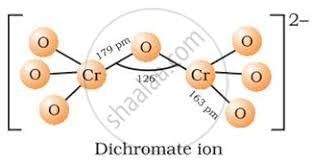

- It has no Cr - Cr bonds
- It has no O - O bonds
- It has 8 Cr - O bonds and one Cr - O - Cr bond
Number of diamagnetic lanthanide ions amongLa3+, Ce3+ Ce4+, Gd3+,Yb2+,Yb3+,Lu2+, Lu3+ are
Correct answer is '4'. Can you explain this answer?
Number of diamagnetic lanthanide ions among
La3+, Ce3+ Ce4+, Gd3+,Yb2+,Yb3+,Lu2+, Lu3+ are
|
|
Rhea Iyer answered |
La3+, Ce4+, Yb2+ and Lu3+ are diamagnetic in nature.
Which one of the following is a diamagnetic ion?- a)CO2+
- b)Cu2+
- c)Mn2+
- d)Sc3+
Correct answer is option 'D'. Can you explain this answer?
Which one of the following is a diamagnetic ion?
a)
CO2+
b)
Cu2+
c)
Mn2+
d)
Sc3+
|
|
Ameya Pillai answered |
Co2+ (Z = 27) : [Ar]183d7 (3 unpaired electrons)
Cu2+ (Z = 29) : [Ar]183d9 (1 unpaired electrons)
Mn2+ (Z = 25): [Ar]183d5 (5 unpaired electrons)
Sc3+ (Z = 21): [Ar]183d0 (No unpaired electron)
Sc3+ with no unpaired electron will be diamagnetic
Cu2+ (Z = 29) : [Ar]183d9 (1 unpaired electrons)
Mn2+ (Z = 25): [Ar]183d5 (5 unpaired electrons)
Sc3+ (Z = 21): [Ar]183d0 (No unpaired electron)
Sc3+ with no unpaired electron will be diamagnetic
Only One Option Correct TypeDirection (Q. Nos. 1-10) This section contains 10 multiple choice questions. Each question has four choices (a), (b), (c) and (d), out of which ONLY ONE is correct.Q. Atomic number of second transition series lies from- a)38 to 47
- b)39 to 48
- c)40 to 49
- d)41 to 50
Correct answer is option 'B'. Can you explain this answer?
Only One Option Correct Type
Direction (Q. Nos. 1-10) This section contains 10 multiple choice questions. Each question has four choices (a), (b), (c) and (d), out of which ONLY ONE is correct.
Q.
Atomic number of second transition series lies from
a)
38 to 47
b)
39 to 48
c)
40 to 49
d)
41 to 50

|
Khushi Mittal answered |
Transition series means d-block elements which have 10 elements in one series.... according to the question 2nd d block elements includes elements from atomic number 39 (i.e.yttrium) to atomic number 48(i.e. cadmium)
Ag+ ion is isoelectronic with- a)Zn2+
- b)Cd2+
- c)Pd2+
- d)Cu2+
Correct answer is option 'B'. Can you explain this answer?
Ag+ ion is isoelectronic with
a)
Zn2+
b)
Cd2+
c)
Pd2+
d)
Cu2+

|
Malavika Shah answered |
Ag+ is isoelectronic with Cd2+
When an alkali is added to an orange red solution of dichromate, it forms:- a)Ferrochrome
- b)Chromyl chloride
- c)Chromate
- d)Chromium trioxide
Correct answer is option 'C'. Can you explain this answer?
When an alkali is added to an orange red solution of dichromate, it forms:
a)
Ferrochrome
b)
Chromyl chloride
c)
Chromate
d)
Chromium trioxide

|
Knowledge Hub answered |
The correct answer is C
When an alkali is added to an orange red solution of dichromate it forms chromate.
For example:
K2Cr2O7 + 2KOH ➡ 2K2CrO4 + H2O
When an alkali is added to an orange red solution of dichromate it forms chromate.
For example:
K2Cr2O7 + 2KOH ➡ 2K2CrO4 + H2O
Lucas reagent is
- a)ZnCl2 + HCl
- b)MnO2 + H2O
- c)H2SO4 + HCl
- d)NO + H2O
Correct answer is option 'A'. Can you explain this answer?
Lucas reagent is
a)
ZnCl2 + HCl
b)
MnO2 + H2O
c)
H2SO4 + HCl
d)
NO + H2O

|
Arshiya Choudhury answered |
Lucas Test is done to distinguish primary secondary and tertiary alcohols. Lucas reagent is ZnCl2 + HCl
One Integer Value Correct Type
Direction (Q. Nos. 20-23) This section contains 4 questions. When worked out will result in an integer from 0 to 9 (both inclusive
Q.
The number of moles of FeC2O4 that reduces two moles of KMnO4 in acidic medium are
Correct answer is between '3.3,3.4'. Can you explain this answer?
One Integer Value Correct Type
Direction (Q. Nos. 20-23) This section contains 4 questions. When worked out will result in an integer from 0 to 9 (both inclusive
Q.
The number of moles of FeC2O4 that reduces two moles of KMnO4 in acidic medium are

|
Om Kumar answered |
Balanced equation,
6KMnO4 + 10FeC2O4 + 24H2SO4 → 3K2SO4 + 6MnSO4 + 5Fe2(SO4)3 + 20 CO2 + 24 H2O
Thus, 6 moles of KMnO4 react with 10FeC2O4.
Hence, 2 moles of KMnO4 react with
Which one of the following statement(s) is/are incorrect for lanthanides?- a)Lanthanide metal ions are mostly coloured
- b)Lanthanides have high melting and boiling points
- c)Lanthanides have low densities
- d)Lanthanides have high ionisation energy
Correct answer is option 'C'. Can you explain this answer?
Which one of the following statement(s) is/are incorrect for lanthanides?
a)
Lanthanide metal ions are mostly coloured
b)
Lanthanides have high melting and boiling points
c)
Lanthanides have low densities
d)
Lanthanides have high ionisation energy

|
Shraddha Gupta answered |
The hardness increases with increasing atomic number.
If molarity of K2Cr2O7 solution is 0.5 M, its normality value is
Correct answer is '3'. Can you explain this answer?
If molarity of K2Cr2O7 solution is 0.5 M, its normality value is

|
Ishani Patel answered |
Normality = molarity x number of electrons gained per mole of dichromate in a redox reaction. Hence, Normality = Molarity x 6
The element with atomic number 62 belongs- a)III A group and 6th period
- b)III B group and 7th period
- c)IV B group and 7th period
- d)III B group and 6th period
Correct answer is option 'D'. Can you explain this answer?
The element with atomic number 62 belongs
a)
III A group and 6th period
b)
III B group and 7th period
c)
IV B group and 7th period
d)
III B group and 6th period

|
Anoushka Chopra answered |
Samarium (Sm) (Z = 62) belongs to III B group and 6th period.
Number of elements that generally do not show variable valencies Cu, Zn Au, Cd, Sc, La, Pt, Co.
Correct answer is '4'. Can you explain this answer?
Number of elements that generally do not show variable valencies Cu, Zn Au, Cd, Sc, La, Pt, Co.
|
|
Gaurav Kumar answered |
Zn, Cd, Sc and La do not show variable valencies.
Which has lowest and highest first ionisation enthalpy in 3d series?- a)Sc and Zn
- b)Zn and Sc
- c)Cu and Zn
- d)Cr and Zn
Correct answer is option 'A'. Can you explain this answer?
Which has lowest and highest first ionisation enthalpy in 3d series?
a)
Sc and Zn
b)
Zn and Sc
c)
Cu and Zn
d)
Cr and Zn

|
Beyond the Horizon answered |
Losing one electron gives Sc noble gas configuration (Ar). While Zn has d10 s2 configuration so it won't give its electron easily. So, it has high ionization enthalpy.
The colourless ions among the lanthanides are- a)La3+
- b)Gd3+
- c)Lu3+
- d)Ce3+
Correct answer is option 'A,B,C,D'. Can you explain this answer?
The colourless ions among the lanthanides are
a)
La3+
b)
Gd3+
c)
Lu3+
d)
Ce3+

|
Keerthana Mehta answered |
La3+, Gd3+ and Lu3+ have empty (4f0) half-filled (4f7) and full-filled (4f14) orbitals. Ce3+ (4f1) is colourless because it does not absorb in the visible region.
One mole of each KMnO4 and K2Cr2O7 can oxidise ........... moles of ferrous ion.- a)5 and 5
- b)5 and 6
- c)6 and 5
- d)6 and 6
Correct answer is option 'B'. Can you explain this answer?
One mole of each KMnO4 and K2Cr2O7 can oxidise ........... moles of ferrous ion.
a)
5 and 5
b)
5 and 6
c)
6 and 5
d)
6 and 6

|
Gauri Khanna answered |
One equivalent of KMnO4 = One equivalent of K2Cr2O7 = One equivalent of Fe2+ ion or 1/5 moles of KMnO4 = 1/6 moles of K2Cr2O7 = One mole of Fe2+ ion.
Hence, one mole of KMnO4 reacts with 5 moles of Fe2+ ion and one mole of K2Cr2O7 reacts with 6 moles of Fe2+ ion.
Hence, one mole of KMnO4 reacts with 5 moles of Fe2+ ion and one mole of K2Cr2O7 reacts with 6 moles of Fe2+ ion.
The pair of ions that have same electronic configuration- a)Fe2+ and Mn2+
- b)Fe2+ and Co3+
- c)Fe3+ and Co3+
- d)V2+ and Cr3+
Correct answer is option 'B,D'. Can you explain this answer?
The pair of ions that have same electronic configuration
a)
Fe2+ and Mn2+
b)
Fe2+ and Co3+
c)
Fe3+ and Co3+
d)
V2+ and Cr3+

|
Saikat Dey answered |
You simply count the electron number, though , co is present just after fe, so from this logic you count the electron number is same in fe2+ and co3+,(just think) simultaneously v2+, cr3+ electron number is same, in mathematical, fe 2+ electron number is 26-2=24,, and co 3+,electron number is 27-3=24,so simultaneously v2+, and cr 3+ has same number of electron,
The observed oxidation state of lanthanides either in solution or in insoluble compounds form tripositive cations. Based on the ionisation enthalpies and hydration energy factors, it is concluded that tripositive species is more stable than di or tetrapositive species in aqueous solution. In general, ions having half-filled (Tb4+ , Eu2+ , Gd3+) or completely filled 4f orbitals (Yb2+, Lu3+) or noble gas configuration (La3+, Ce4+) are stable. This is supported by their SRP values. Ions with + 4 oxidation state act as oxidising and ions having + 2 oxidation state act as reducing agents. Ions having same number of unpaired electrons in f-orbitals possess same colour.
Q. Which is correct statement?
- a)Ce4+ is more stable than Ce3+ in solution
- b)Ce3+ is more sable than Ce4+ in solution
- c)Ce4+ and Ce3+ are equally stable
- d)Ce4+ has xenon configuration
Correct answer is option 'B'. Can you explain this answer?
The observed oxidation state of lanthanides either in solution or in insoluble compounds form tripositive cations. Based on the ionisation enthalpies and hydration energy factors, it is concluded that tripositive species is more stable than di or tetrapositive species in aqueous solution. In general, ions having half-filled (Tb4+ , Eu2+ , Gd3+) or completely filled 4f orbitals (Yb2+, Lu3+) or noble gas configuration (La3+, Ce4+) are stable. This is supported by their SRP values. Ions with + 4 oxidation state act as oxidising and ions having + 2 oxidation state act as reducing agents. Ions having same number of unpaired electrons in f-orbitals possess same colour.
Q. Which is correct statement?
a)
Ce4+ is more stable than Ce3+ in solution
b)
Ce3+ is more sable than Ce4+ in solution
c)
Ce4+ and Ce3+ are equally stable
d)
Ce4+ has xenon configuration
|
|
Nabanita Sen answered |
Ce4+ is [Xe] 4f0, it tends to revert to more stable oxidation state of +3 by gain of an electron. That is why, in aqueous solution, Ce4+ is good oxidising agent.
An element has configuration 4d55s2. The element belongs to- a)3rd group and 4th period
- b)5th group and 5th period
- c)7th group and 5th period
- d)7th group and 7th period
Correct answer is option 'C'. Can you explain this answer?
An element has configuration 4d55s2. The element belongs to
a)
3rd group and 4th period
b)
5th group and 5th period
c)
7th group and 5th period
d)
7th group and 7th period
|
|
Lavanya Menon answered |
Ford-block elements, group number is equal to the number of electrons in (n - 1)d subshell + number of electrons in valence shell (nth shell).
Mohr’s salt is a- a)Acidic salt
- b)Double salt
- c)Basic Acidic salt
- d)Normal salt
Correct answer is option 'B'. Can you explain this answer?
Mohr’s salt is a
a)
Acidic salt
b)
Double salt
c)
Basic Acidic salt
d)
Normal salt

|
Amar Pillai answered |
Mohr salt is an example of double salt. Mohr Salt is
FeSO4 . (NH4)2 SO4.6H2O
Which is called chromic acid?- a)Cr2O3
- b)Cr3O4
- c)CrO
- d)H2CrO4
Correct answer is option 'D'. Can you explain this answer?
Which is called chromic acid?
a)
Cr2O3
b)
Cr3O4
c)
CrO
d)
H2CrO4
|
|
Shraddha Dey answered |
Chromic Acid is a naturally occurring oxide with a formula H2CrO4.
Chapter doubts & questions for D and F - Block Elements - Chemistry CUET UG Mock Test Series 2026 2025 is part of NEET exam preparation. The chapters have been prepared according to the NEET exam syllabus. The Chapter doubts & questions, notes, tests & MCQs are made for NEET 2025 Exam. Find important definitions, questions, notes, meanings, examples, exercises, MCQs and online tests here.
Chapter doubts & questions of D and F - Block Elements - Chemistry CUET UG Mock Test Series 2026 in English & Hindi are available as part of NEET exam.
Download more important topics, notes, lectures and mock test series for NEET Exam by signing up for free.

Contact Support
Our team is online on weekdays between 10 AM - 7 PM
Typical reply within 3 hours
|
Free Exam Preparation
at your Fingertips!
Access Free Study Material - Test Series, Structured Courses, Free Videos & Study Notes and Prepare for Your Exam With Ease

 Join the 10M+ students on EduRev
Join the 10M+ students on EduRev
|

|
Create your account for free
OR
Forgot Password
OR
Signup on EduRev and stay on top of your study goals
10M+ students crushing their study goals daily

